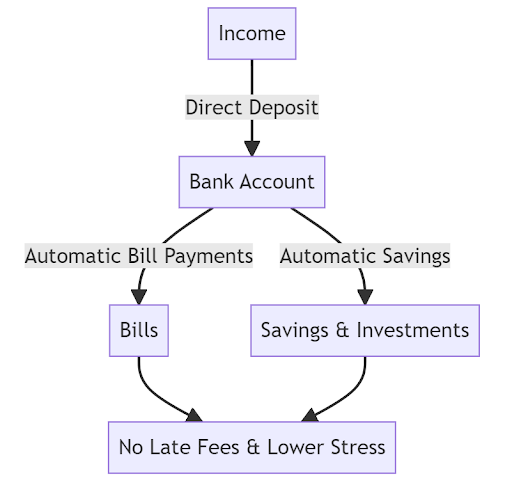Ever dreamt of a personal assistant who could take care of your bills, make sure your savings grow and essentially put your money matters on autopilot? That's exactly what financial automation does.
When you automate your finances, you do more than just organize them; you give them a goal and a plan. Setting up automatic systems can help you save time, feel less stressed, and keep your finances in order.
Now that's smart finance!
If you've ever felt overwhelmed juggling bill payments, savings, and investments, or if you've simply wondered if there's a better way to manage your money or set your money on autopilot, you've come to the right place.
Let's take the guesswork out of personal finance and put your money to work for you.
Understanding Your Financial Landscape

Before you dive headfirst into the world of financial automation, it's important to evaluate your current financial status.
Begin by making a comprehensive list of all the accounts you use regularly, like your checking accounts and credit cards. Take note of all your monthly expenses associated with these accounts, along with their due dates.
Focus on obligations with fixed due dates like utilities, rent, and loan repayments. This simple exercise gives you a clear snapshot of your financial operations, helping you devise a plan that fits your lifestyle and meets your financial goals.
The Many Faces of Financial Automation
The beauty of financial automation is that it can encompass pretty much every aspect of your financial life. Bills, we've got you covered! Savings goals, consider it done!
Let's explore some of the key areas where you can set your money on autopilot;
Bills on Auto-Pilot
You can automate your monthly commitments, like:
– Rent or mortgage
– Utilities
– Credit card payments
– Loan repayments
– Insurance premiums
Just set it up once, and you're done. It's like setting a playlist on repeat. Your bills get paid on time, every time, without you having to lift a finger.
To streamline this process even more, consider consolidating your bill due dates to fall on the same day or within a few days of each other – specifically around when you get paid. This simplifies tracking and gives you better control over your cash flow.
Growing Your Wealth Automatically
But why stop at bills? Let's automate your future wealth and set your money on autopilot. Regular contributions to your savings and investments can also be automated.
Whether it's your retirement account, emergency fund, or short-term savings, you can have automatic contributions set up for these too. Just imagine your money growing while you sleep.
Now that's what we call financial freedom!
READ ALSO: The Step-by-Step Guide to Mastering the Art of Zero-Based Budgeting
The How-To of Financial Automation

So, how do you get this money magic to work for you? Here are the steps you need to take to set your money on autopilot:
Step 1: Choose Your Method
Depending on your comfort level and your service providers, you can opt for any of these methods:
- ⭐ Option A: Auto Debits from Service Providers: Many service providers, like utility companies or credit card companies, offer an auto-debit feature. You simply give them permission to deduct their bill amount from your account each month.
- ⭐ Option B: Bank Bill Pay: If you'd rather keep things in one place, most banks offer a bill pay service. You tell your bank where to send the money, and they handle it from there.
- ⭐ Option C: Direct Deposit: If your employer offers it, direct deposit is a great way to streamline your income. You can even split your deposit across different accounts.
Step 2: Prioritize Automatic Savings
Remember that automatic saving we talked about? Here's how you do it:
- ⭐ Automate Retirement Contributions: Reach out to your HR department and set up an automatic deduction for your retirement contributions. Try to aim for at least 10% of your pre-tax income, or enough to get the full employer match, if it's available.
- ⭐ Set Up Automated Transfers to Savings: Get a portion of your paycheck sent directly to your emergency fund and other savings accounts. If your income is inconsistent, set up calendar reminders to transfer funds when you know you'll have money coming in.
Step 3: Design Your Budget
Now that your savings and bills are automated, create a budget for the remaining balance. This budget will guide your spending and ensure your money is being put to good use.
Consider the following:
- ⭐ Allocate Your Paycheck: Establish a rule to divide your paycheck into different categories – 50% for essentials like rent and bills, 30% for discretionary spending, and 20% for savings.
- ⭐ Set Up Direct Deposit: You can ask your HR department to directly deposit these portions into different accounts, effectively automating your budgeting.
- ⭐ Create Separate Accounts: Consider opening a separate checking account for discretionary spending and a high-yield savings account for your savings.
Step 4: Keep Track of Your Due Dates
To avoid any financial mishaps, make sure you know when your bills are due and ensure you'll have enough funds to cover them. A budget calendar can be a great tool to keep track of everything and set your money on autopilot.
READ ALSO: Saving Money on a Tight Budget: Strategies and Tips to Help You Succeed
Step 5: Regularly Review Your Accounts
Automation doesn't mean set it and forget it. Make it a habit to check your bank statements and account balances regularly. This way, you'll stay on top of your finances and spot any issues before they become problems.
Customize Your Automation Plan

Remember, the goal of financial automation is to make money management easier for you. If the tips mentioned above don't resonate with your financial situation, feel free to customize your plan.
You might want to set up different accounts for specific goals or automate contributions to your investment accounts. The power to create an effective automation system lies in your hands.
Regularly Review Your Automation System
While automating your finances minimizes daily involvement, it doesn't mean you should completely forget about them. Circumstances change, and unexpected expenses can arise. Therefore, it's crucial to review your automation system regularly and make adjustments as needed.
With a proactive approach, you can ensure your financial automation serves your evolving needs and keeps your financial health in check.
READ ALSO: How to Set Financial Goals That Stick
Experience the Freedom of Financial Automation
Getting your finances on autopilot might take some time to set up, but trust me, it's worth it. Once you have everything in place, you'll be able to focus more on what matters most to you while your money is hard at work.
So, why wait? Start automating your finances today, set your money on autopilot and watch your financial future unfold!
To help illustrate the process and the benefits of financial automation, consider the following diagram:

With the above setup, your income flows into your bank account automatically. From there, it's automatically divided between bills and savings, leaving you worry-free and your financial future secure.
Now, that's smart finance!









